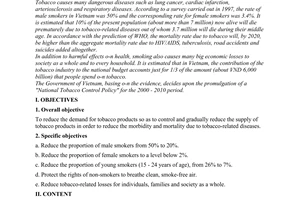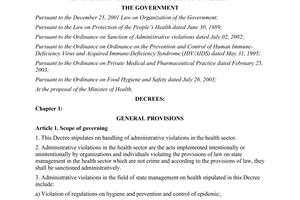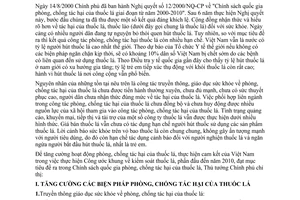Nội dung toàn văn Directive No. 12/2007/CT-TTg of May 10, 2007, on intensifying tobacco harm prevention and combat activities.
|
THE
PRIME MINISTER OF GOVERNMENT |
SOCIALIST
REPUBLIC OF VIET NAM |
|
No: 12/2007/CT-TTg |
Hanoi , May 10, 2007 |
DIRECTIVE
ON INTENSIFYING TOBACCO HARM PREVENTION AND COMBAT ACTIVITIES
On August 14, 2000, the Government issued Resolution No. 12/2000/NQ-CP on national policies on tobacco harm prevention and combat in the 2000-2010 period. After six years' implementing the Resolution, initial encouraging results have been achieved. The community now has a greater awareness and a deeper understanding of tobacco harms to health. The number of people who voluntarily give up smoking is growing. However, as compared with set objectives, the results of tobacco harm prevention and combat remain limited. Vietnam is still among countries with the highest smoker percentages in the world. According to the World Health Organization's forecasts, unless preventive measures are taken in time, about 10% of the Vietnamese population will die young of tobacco-related diseases. According to a recent national medical survey, the percentage of male smokers tends to increase; the percentage of children being second smokers is very high; and smoking in public places remains popular.
Above existing problems are attributed to the fact that communication and education about tobacco harm prevention and combat have not been carried out in a regular, drastic and persuasive manner, failing to develop proper public awareness about tobacco harms. Coordination among branches in tobacco harm prevention and combat remains weak while social resources have not been fully tapped for tobacco harm prevention and combat. Tobacco advertisement, sales promotion and marketing as well as sponsorship are still carried out by tobacco companies in different forms. Tobacco prices are still incapable of restraining the consumption of tobacco products by smokers. Health warnings printed on cigarette packs are too general, failing to make a strong impression on consumers and, therefore, see limited warning effects on tobacco addicts and potential smokers, especially children.
In order to intensify tobacco harm prevention and combat and realize Vietnam's commitments on the implementation of the Framework Convention on Tobacco Control (FCTC), striving to achieve the objectives set in the national policies on tobacco harm prevention and combat by 2010, the Prime Minister instructs:
I. INCREASING MEASURES FOR TOBACCO HARM PREVENTION AND COMBAT
1. Communication and education about tobacco harm prevention and combat:
a/ To enhance communication and education about tobacco harm prevention and combat on the mass media, in agencies, workplaces and among the community in order to raise public awareness and change behaviors of people for tobacco harm prevention and combat. To propagate and mobilize cadres, civil servants, state employees and members of mass organizations to refrain from smoking;
b/ To propagate and mobilize people to reduce and then stop the use and offer of cigarettes at wedding parties, funerals, festivals and family parties.
2. Strict enforcement of the ban on smoking in workplaces and indoor public places:
a/ To ban smoking in classrooms, kindergartens, medical establishments, indoor production areas and workplaces; places highly prone to fire and explosion; and mass transit vehicles. "No smoking" signs or symbols must be put up at places where smoking is banned;
b/ To arrange separate smoking areas at indoor public places (libraries, cinemas, theaters, cultural houses, sports competition facilities, roofed stadiums, exhibition centers, lounges of stations, car terminals, airports and seaports) and indoor recreational and entertainment areas, restaurants, bars, karaoke parlors, hotels and dance halls;
c/ To treat violations of regulations on tobacco harm prevention and combat as violations of internal rules and regulations of agencies, units and public places.
3. Implementation of the FCTC's provisions on the printing of health warnings on cigarette packs according to a set roadmap:
a/ As from March 17, 2008, to print the health warning "Smoking can cause lung cancer" on the background of contrasting color, accounting for around 30% of the surface area of a cigarette pack; as from January 1, 2010, to print the health warning on around 50% of the surface area of a cigarette pack.
b/ To comply with current regulations on other issues of hygiene and safety of tobacco products.
4. Promotion of the control of tobacco product trading:
a/ To strictly prohibit the sale of tobacco products at agencies, workplaces, schools, hospitals, on mass transit vehicles and at places where smoking is banned as specified at Point a, Clause 2, Section I, of this Directive;
b/ To strictly control the tobacco product wholesale and wholesale agency through regular inspection and examination of traders, proceeding to control tobacco product retail by prescribing locations, scope, scale and time of tobacco product trading, and the number of tobacco product traders in conformity with the socio-economic development plan of each locality under the Trade Ministry's guidance;
c/ To enhance effective coordination among anti-smuggling forces in fighting the trading in smuggled cigarettes, fake cigarettes, cigarettes with imitation brands and poor-quality cigarettes;
d/ To prohibit the sale of cigarettes by automated vending machines, via the Internet or telephone;
e/ To destroy smuggled cigarettes, fake cigarettes, cigarettes with imitation brands and poor-quality cigarettes.
5. Intensified enforcement of the implementation of the ban on tobacco advertisement, sales promotion and marketing and sponsorship activities for the purposes of cigarette production and trading:
a/ To strictly enforce the ban on cigarette advertisement, sales promotion and marketing as well as the use of cigarettes as sales promotion products for other goods and services in all forms;
b/ To ban all forms of direct and indirect sponsorship carried out by tobacco product traders and manufacturers linked with advertisement of tobacco products;
c/ To prohibit organizations, units and individuals from receiving sponsorship for organizing cultural, artistic, sports, recreational, educational and healthcare activities, scientific seminars and other social activities linked with advertisement of tobacco products.
6. Application of tax- and price-related measures to restrict the use of tobacco products: To formulate an appropriate tax increase roadmap in order to raise the prices of tobacco products with a view to limiting people's access to and use of tobacco products.
II. ORGANIZATION OF IMPLEMENTATION
1. The Ministry of Health:
a/ To act as a focal point coordinating with ministries, branches and socio-political organizations in directing the implementation of the program on tobacco harm prevention and combat; to organize the national smoke-free week every year; to organize communication and education about tobacco harm prevention and combat; to encourage the implementation of research schemes on tobacco harms and smoking detoxification measures for application in the community; to carry out regular inspection and examination; to evaluate, review and annually report the results of tobacco harm prevention and combat to the Prime Minister;
b/ To assume the prime responsibility for, and coordinate with the Ministry of Science and Technology and the Ministry of Culture and Information in, specifying and inspecting the printing of health warnings on the front surface of cigarette packs; to formulate national technical regulations on cigarette safety and hygiene;
c/ To coordinate with the inspectorates of concerned ministries, branches and localities in examining, inspecting and strictly handling violations of Article 16 of the Government's Decree No. 45/2005/ND-CP of April 6, 2005, on sanctioning of administrative violations in the health domain;
d/ To draft and submit the Bill on tobacco harm prevention and combat to the Government for consideration and subsequent submission to the National Assembly for inclusion in the National Assembly's 2008 legislative program;
e/ To integrate activities of communication about tobacco harm prevention and combat into healthcare programs and other social programs such as the program on reproductive health, the anti-HIV/AIDS program and the program on building healthy cultured villages.
2. The Ministry of Culture and Information:
a/ To direct the mass media and grassroots information agencies to accelerate the communication and education about tobacco harm prevention and combat in order to change smoking behaviors; to adopt measures to restrict to the utmost the use of smoking images on or in artistic works;
b/ To direct its functional agencies to tightly oversee the enforcement of the ban on tobacco advertisement and handle violating organizations and individuals according to law.
3. The Ministry of Education and Training and the Ministry of Labor, War Invalids and Social Affairs:
a/ To incorporate tobacco harm prevention and combat knowledge and skills into extra-curricular programs for students of universities, colleges, professional secondary schools, job-training schools and general schools in conformity with the requirements of each target group;
b/ To boost tobacco harm prevention and combat in education establishments; to build non-smoking education establishments; to launch and maintain anti-smoking movements in education establishments.
4. The Ministry of Trade:
a/ To tightly control tobacco product wholesale and wholesale agency according to current regulations; to strictly handle violations of regulations on sales promotion, marketing and trading of tobacco products;
b/ To coordinate with functional agencies in proposing and effectively applying measures against cigarette smuggling, fake cigarettes, cigarettes with imitation brands and poor-quality cigarettes according to law; to work out and direct the implementation of plans on destruction of smuggled cigarettes, fake cigarettes, cigarettes with imitation brands and poor-quality cigarettes; to work out annual plans on allocation of budgetary sources for this work.
5. The Ministry of Industry:
a/ To direct and strictly manage the tobacco industry in accordance with set plannings and plans, from growing of tobacco plants, processing of raw materials to production and consumption of tobacco products; to boost production so as to raise the productivity and quality of home-made tobacco raw materials in substitution of imported ones;
b/ To assume the prime responsibility for, and coordinate with concerned agencies in reorganizing cigarette enterprises in conformity with plannings; to enhance the management of investment in, import and use of cigarette production equipment, cigarette papers, tobacco raw materials and tobacco products according to current regulations.
6. The Ministry of Finance:
a/ To balance and ensure financial sources for activities under the Program on tobacco harm prevention and combat within the annual budget expenditure estimates of ministries, branches and localities according to current regulations and budget decentralization;
b/ To evaluate impacts of special consumption tax policies on the consumption of tobacco products and state revenues. To continue studying and proposing a tax-increase roadmap in order to reduce the use of tobacco products;
c/ To issue a circular to guide the pilot mechanism on mobilization of financial sources for prevention and combat of cigarette smuggling and fake cigarettes.
7. The Ministry of Planning and Investment;
a/ To coordinate with the Ministry of Industry and concerned agencies in managing investment in the tobacco industry according to the Government's regulations; to take the initiative in proposing measures for handling cigarette production join ventures which violate the law on tobacco harm prevention and combat;
b/ To coordinate with the Ministry of Industry and concerned ministries and branches in managing the investment in cigarette production according to current regulations.
8. The Committee for Population, Family and Children: To enhance the education and propagation about prevention and combat of harms caused by smoking to children and pregnant women. To mobilize families, schools and society to participate in preventing cigarette sale, purchase and use by children.
9. The Vietnam Television Station, the Radio Voice of Vietnam and the Vietnam News Agency:
a/ To coordinate with communication agencies in increasing the broadcasting time and publication of information on tobacco harm prevention and combat and dissemination of the law on tobacco harm prevention and combat and smoking detoxification measures;
b/ To develop special columns and programs on tobacco harm prevention and combat. To restrict the publication of works containing smoking images.
10. Ministries and branches shall coordinate with the Central Committee of the Vietnam Fatherland Front, the Vietnam General Confederation of Labor, the Vietnam Peasants' Association, the Vietnam Women's Union, the Ho Chi Minh Communist Youth Union and the Vietnam War Veterans' Association in elaborating and promulgating documents to guide tobacco harm prevention and combat; and to create favorable conditions for social organizations to take part in tobacco harm prevention and combat activities.
11. Provincial/municipal People's Committees:
a/ To direct provincial-level Health Services to assume the prime responsibility for, and coordinate with other branches in, intensifying tobacco harm prevention and combat activities; to conduct examination and inspection and strictly handle violations of the provisions of Article 16 of the Government's Decree No. 45/2005/ND-CP of April 6, 2005, on sanctioning of administrative violations in the health domain in their localities;
b/ To direct local communication agencies to boost communication and education about tobacco harm prevention and combat in order to change smoking behavior; to regularly conduct dissemination and education of the law on tobacco harm prevention and combat and smoking detoxification measures;
c/ To further socialize activities of tobacco harm prevention and combat, incorporate the issue of tobacco harm prevention and combat into resolutions, rules and regulations of agencies and units or local village conventions.
This Directive takes effect 15 days after its publication in "CONG BAO."
Ministries, branches and provincial/municipal People's Committees shall base themselves on this Directive to formulate tobacco harm prevention and combat plans in their respective agencies and units and allocate funds for this work according to current regulations.
Ministers, heads of ministerial-level agencies and government-attached agencies and presidents of provincial/municipal People's Committees shall organize the implementation of this Directive, and annually send reports on the results of tobacco harm prevention and combat in their respective agencies or localities to the Ministry of Health for sum-up and reporting to the Prime Minister.
|
|
THE PRIME
MINISTER |


